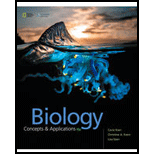
Concept explainers
Introduction:
All the organisms present in the environment is composed of a cell. The organisms are classified into two types. These are prokaryotes and eukaryotes. Prokaryotes are the organisms that do not contain a well-defined nucleus. However, eukaryotes have a well-defined nucleus properly enclosed in a nuclear membrane. A
Answer to Problem 1SA
Correct answer:
All the fungi are heterotrophs as they depend on other organisms for food. They are not capable of producing their own food. Hence, the correct answer is option c.
Explanation of Solution
Reason for correct answer:
Option c. is given as “are heterotrophs.”
The organisms that are capable of preparing their food by the process of photosynthesis are termed as autotrophs. However, the organisms that cannot prepare food and depend on other organisms are termed as heterotrophs. Fungus is also a heterotroph as it depends on other organisms for food.
Reason for incorrect answer:
Option a. is given as, “are multicelled.”
The organisms that contain one cell are called unicellular or single-celled organisms. However, the ones that are composed of more than one cell are called multicelled organisms. Fungi can be both single-celled and multicelled. The fungi with one cell are called yeasts. Hence, option a. is incorrect.
Option b. is given as, “form flagellated spores.”
Fungi have the ability to produce spores. They can produce a variety of spores such as both flagellated and non-flagellated spores. Chyratids is the only type of fungi that produce flagellated spores. However, all other types of fungi produce non-flagellated spores. Hence, option b. is incorrect.
Option d. is given as, “all of the above.”
The only correct option that holds correct for fungi is option c. This is because fungi are heterotrophic organisms as they cannot prepare their own food. However, all the other options do not explain the characteristic of fungi accurately. Hence, option d. is incorrect.
Hence, the options a., b., and d. are incorrect.
Fungi are the heterotrophic organisms as they cannot prepare food. They are dependent on other organisms for their nutrition. Thus, the correct option is c.
Want to see more full solutions like this?
- Molecular Biology Explain/discuss how “slow stop” and “quick/fast stop” mutants wereused to identify different protein involved in DNA replication in E. coli.arrow_forwardMolecular Biology Question A gene that codes for a protein was removed from a eukaryotic cell and inserted into a prokaryotic cell. Although the gene was successfully transcribed and translated, it produced a different protein than it produced in the eukaryotic cell. What is the most likely explanation?arrow_forwardMolecular Biology LIST three characteristics of origins of replicationarrow_forward
- Molecular Biology Question Please help. Thank you For E coli DNA polymerase III, give the structure and function of the b-clamp sub-complex. Describe how the structure of this sub-complex is important for it’s function.arrow_forwardMolecular Biology LIST three characteristics of DNA Polymerasesarrow_forwardMolecular Biology RNA polymerase core enzyme structure contains what subunits? To form holo enzyme, sigma factor is added to core. What is the name of the structure formed? Give the detailed structure of sigma factor and the function of eachdomain. Please help. Thank youarrow_forward
- Molecular Biology You have a single bacterial cell whose DNA is labelled with radioactiveC14. After 5 rounds of cell division, how may cells will contain radioactive DNA? Please help. Thank youarrow_forward1. Explain the structure and properties of atoms and chemical bonds (especially how they relate to DNA and proteins). Also add some pictures.arrow_forward1. In the Sentinel Cell DNA integrity is preserved through nanoscopic helicase-coordinated repair, while lipids in the membrane are fortified to resist environmental mutagens. also provide pictures for this question.arrow_forward
- Explain the structure and properties of atoms and chemical bonds (especially how they relate to DNA and proteins). Also add some pictures.arrow_forwardIn the Sentinel Cell DNA integrity is preserved through nanoscopic helicase-coordinated repair, while lipids in the membrane are fortified to resist environmental mutagens. also provide pictures for this question.arrow_forward1. Explain how genetic information is stored, copied, transferred, and expressed. Also add some pictures for this question.arrow_forward

 Biology: The Dynamic Science (MindTap Course List)BiologyISBN:9781305389892Author:Peter J. Russell, Paul E. Hertz, Beverly McMillanPublisher:Cengage Learning
Biology: The Dynamic Science (MindTap Course List)BiologyISBN:9781305389892Author:Peter J. Russell, Paul E. Hertz, Beverly McMillanPublisher:Cengage Learning Biology (MindTap Course List)BiologyISBN:9781337392938Author:Eldra Solomon, Charles Martin, Diana W. Martin, Linda R. BergPublisher:Cengage Learning
Biology (MindTap Course List)BiologyISBN:9781337392938Author:Eldra Solomon, Charles Martin, Diana W. Martin, Linda R. BergPublisher:Cengage Learning Concepts of BiologyBiologyISBN:9781938168116Author:Samantha Fowler, Rebecca Roush, James WisePublisher:OpenStax College
Concepts of BiologyBiologyISBN:9781938168116Author:Samantha Fowler, Rebecca Roush, James WisePublisher:OpenStax College Biology Today and Tomorrow without Physiology (Mi...BiologyISBN:9781305117396Author:Cecie Starr, Christine Evers, Lisa StarrPublisher:Cengage Learning
Biology Today and Tomorrow without Physiology (Mi...BiologyISBN:9781305117396Author:Cecie Starr, Christine Evers, Lisa StarrPublisher:Cengage Learning Biology: The Unity and Diversity of Life (MindTap...BiologyISBN:9781305073951Author:Cecie Starr, Ralph Taggart, Christine Evers, Lisa StarrPublisher:Cengage Learning
Biology: The Unity and Diversity of Life (MindTap...BiologyISBN:9781305073951Author:Cecie Starr, Ralph Taggart, Christine Evers, Lisa StarrPublisher:Cengage Learning





